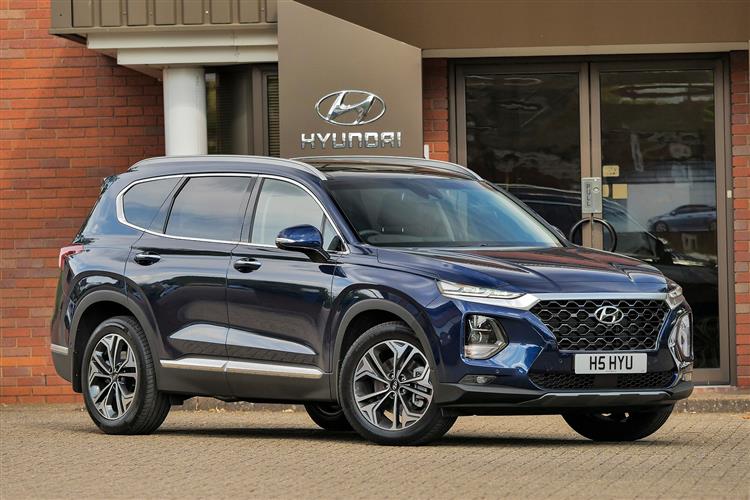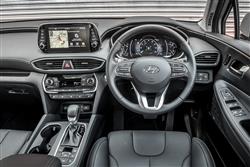SEE YOU IN SANTA FE? (some text hidden) --NONE--
By Jonathan Crouch
Introductionword count: 166
Hyundai is increasingly offering some very high quality cars and one of them was the original version of the fourth generation 'TM'-series design, launched in 2018 and sold only with a diesel engine until Spring 2021. In this early diesel form, the MK4 'TM' generation Santa Fe offered a more spacious, better quality cabin than its direct predecessor and came with seven seats as standard. Plus its 2.2-litre diesel was one of the gutsier offerings in the SUV 'D'-segment from its period. This sleeker MK4 design brought a sharper sense of style to this model line, yet also had a look that hinted at the kind of adventure the brand claimed customers would be able to better exploit thanks to a redeveloped optional 4WD system. It's an SUV for people who probably never thought they'd drive an SUV. A Hyundai for those who probably never thought they'd drive a Hyundai. It also has a level of towing capacity missing from more recent electrified Santa Fe models.
Modelsword count: 7
5dr SUV (EV) [SE, Premium, Premium SE]
Historyword count: 169
The very first Santa Fe was launched back in 2001, that early 'SM'-series model very much a budget brand SUV option. It's second generation successor though, launched five years later, showed that the Korean maker was capable of much more. That 'CM'-series design was the first relatively affordable crossover to blur the boundaries between the mid-sized class and the large SUV segment better suited to bigger families. With it, Santa Fe buyers paid compact sector prices but got the kind of 7-seat capacity they'd previously needed a much larger SUV for: all good. The third generation 'NC'-series model of 2012 built on that success and sold for six years until the original version of the fourth generation 'TM'-series design was first launched - and that's the car we look at here. It sold until Spring 2021, when Hyundai ditched diesel and relaunched this MK4 model with a choice of Hybrid or Plug-in 1.6 T-GDI petrol powertrains. It's the earlier diesel versions of this MK4 model we look at here.
What You Getword count: 573
Over four generations, the Santa Fe has typified an impressive evolution in Hyundai design. This 'TM'-series design was a little bigger than its direct predecessor, as buyers of the previous model might note from a profile perspective. The 70mm length increase may not sound like that much but it was enough to mean that Hyundai this time round had no need to offer the larger Grand Santa Fe body shape that it had previously sold in other markets. It also ensured that this car would take up a parking space around 4.7-metres in long - which in size terms isn't that far off a large luxury SUV - say a Range Rover Sport - from the next class up. The silhouette here though, is a little less stylised than you'd get with a 4x4 of that sort. Primarily because the rear side windows dip deeply towards the waist of the car to improve visibility for passengers riding in the rear. At the wheel, the unusually angular dashboard styling of the previous third generation model was replaced by a layout that proved to be more universally appealing. The central infotainment screen was no longer as seamlessly incorporated into the dash as had been before, its higher positioning making it easier to see. Cabin quality still isn't at premium brand levels but took a noticeable step forward here in a way that'll be particularly evident if you're in an upper-spec variant, with its handcrafted leather seat quilting and textured door speakers. What didn't change here was the properly commanding high-set SUV seating position which delivers impressive all-round visibility from the glassier body shell. More key MK4 model improvements feature relate to the driving instruments. Avoid entry-level trim and the instrument binnacle features a 7-inch central colour TFT display that on the auto model changes colour according to drive mode selection. What about the second row? Well, once you get comfortable, there's a much greater feel of space than was the case with the previous generation version of this model. It's not an illusion either. Hyundai claimed that legroom in this part of the car had been increased by 38mm for this MK4 model, though the actual amount of space you get will depend on the way you position the sliding seat base, which can be moved back and forward across a 300mm range. And the third row? Well once you're in, there is - as advertised - more room than you usually get in the rearmost pews of a typical 'D'-segment 7-seat SUV, thanks to the extra body length we referred to earlier. Here, this freed up just enough room to more comfortably accommodate the couple of full-sized adults who would have been significantly more cramped in the previous generation version of this car. Of course, with the rearmost seats in place, there's won't be much room for luggage - but then of course that's true of any seven-seater that isn't directly based on a van. Lift the tailgate (which is powered above entry-level trim) and you'll find that with all three rows in place, you'll only have enough space for a few shopping bags. Of course, most of the time, you're probably going to be using your Santa Fe with the third row chairs folded flush into the boot floor - which frees up a total of 547-litres of space. Completely flatten the central bench and 1,662-litres of fresh air can be freed up.
To see the full road test text contact us on 0330 0020 227
Pictures (high res disabled)

.jpg)
|
.jpg)
|
.jpg)
| |||
.jpg)
|
.jpg)
|
.jpg)
| |||
.jpg)
|
.jpg)
|
.jpg)
| |||
.jpg)
|
.jpg)
|

|
Scoring (subset of scores)
Category: Crossover or SUV 4x4s
| Performance | |
| Handling | |
| Comfort | |
| Space | |
| Styling, Build, Value, Equipment, Depreciation, Handling, Insurance and Total scores are available with our full data feed. | |



